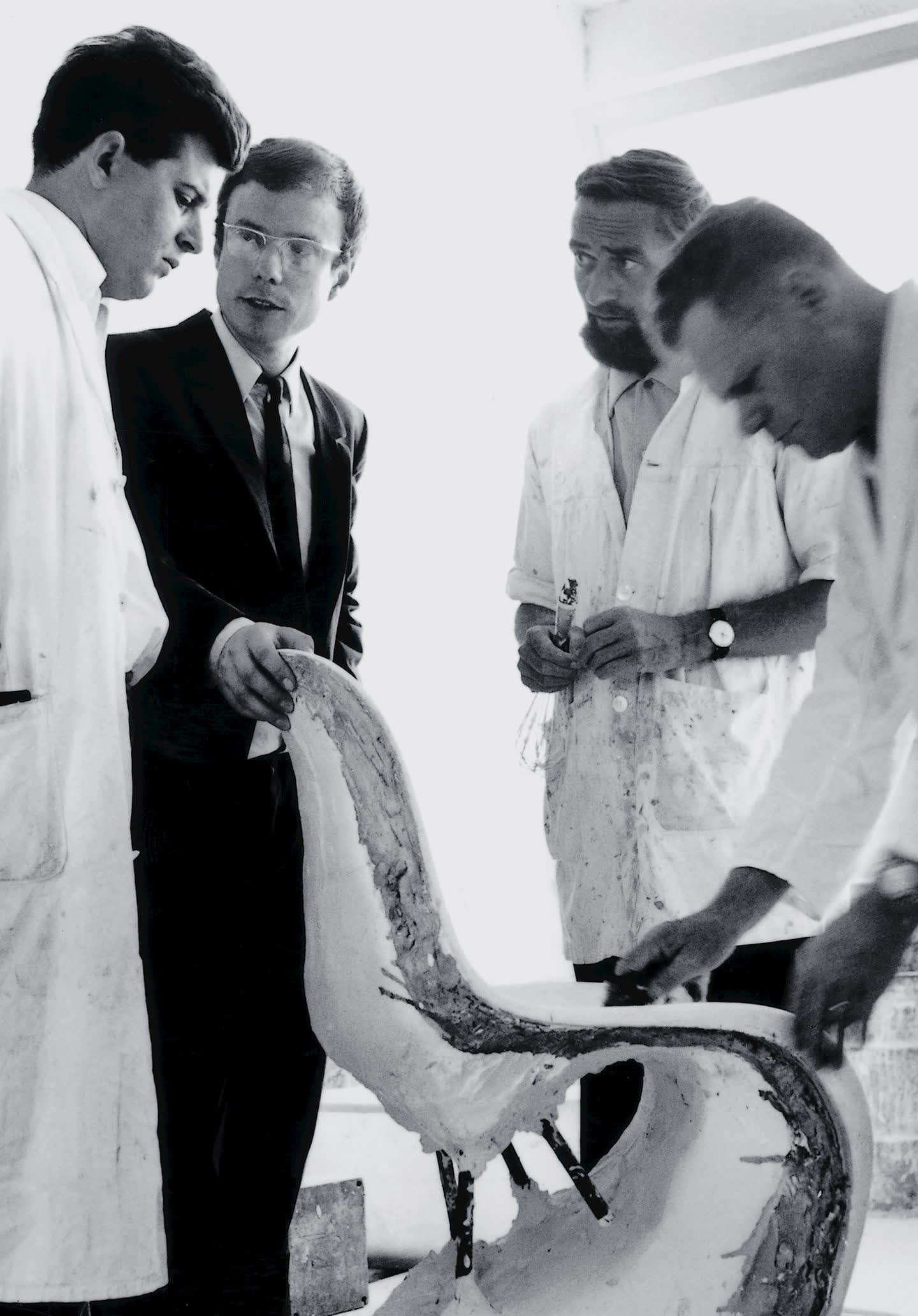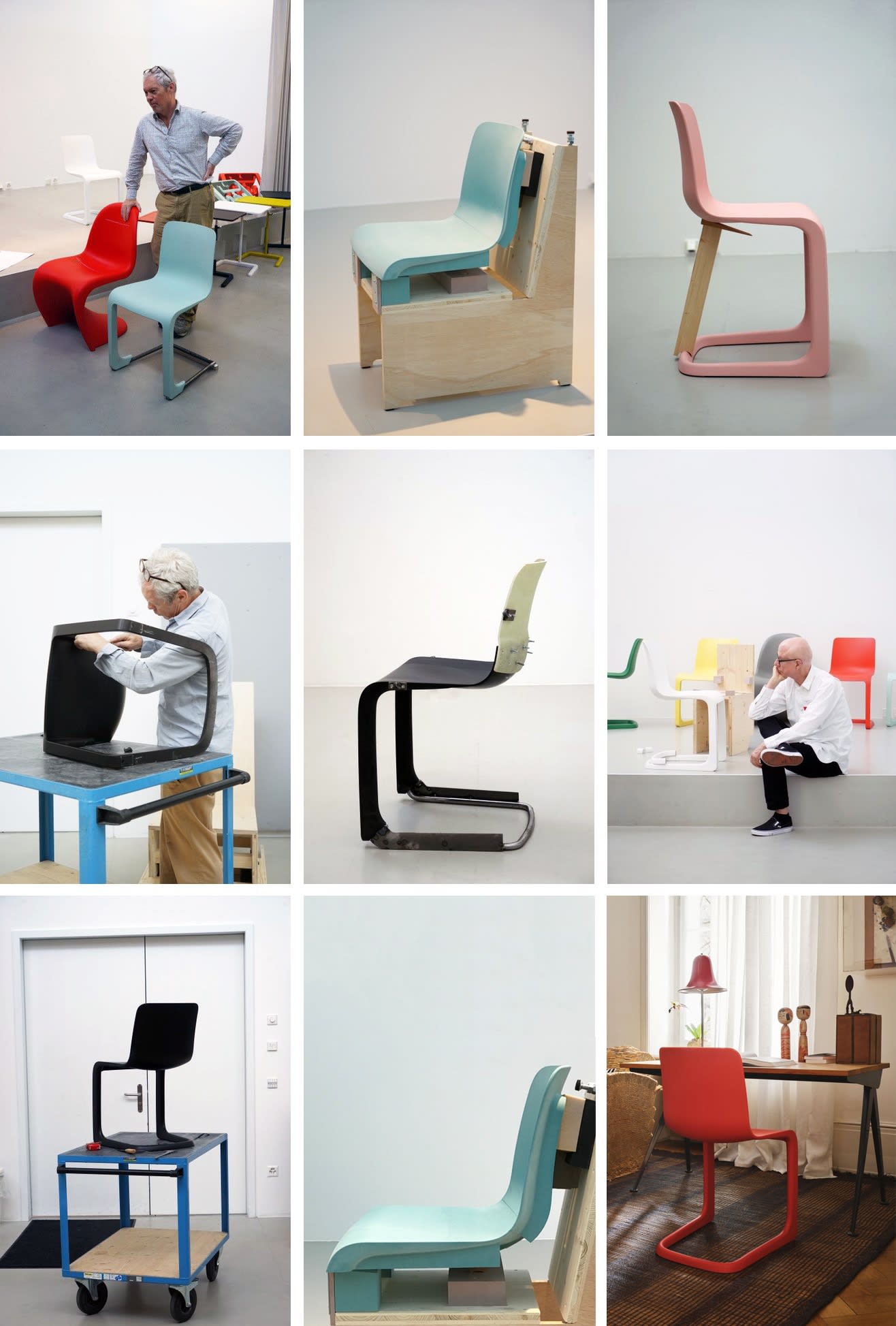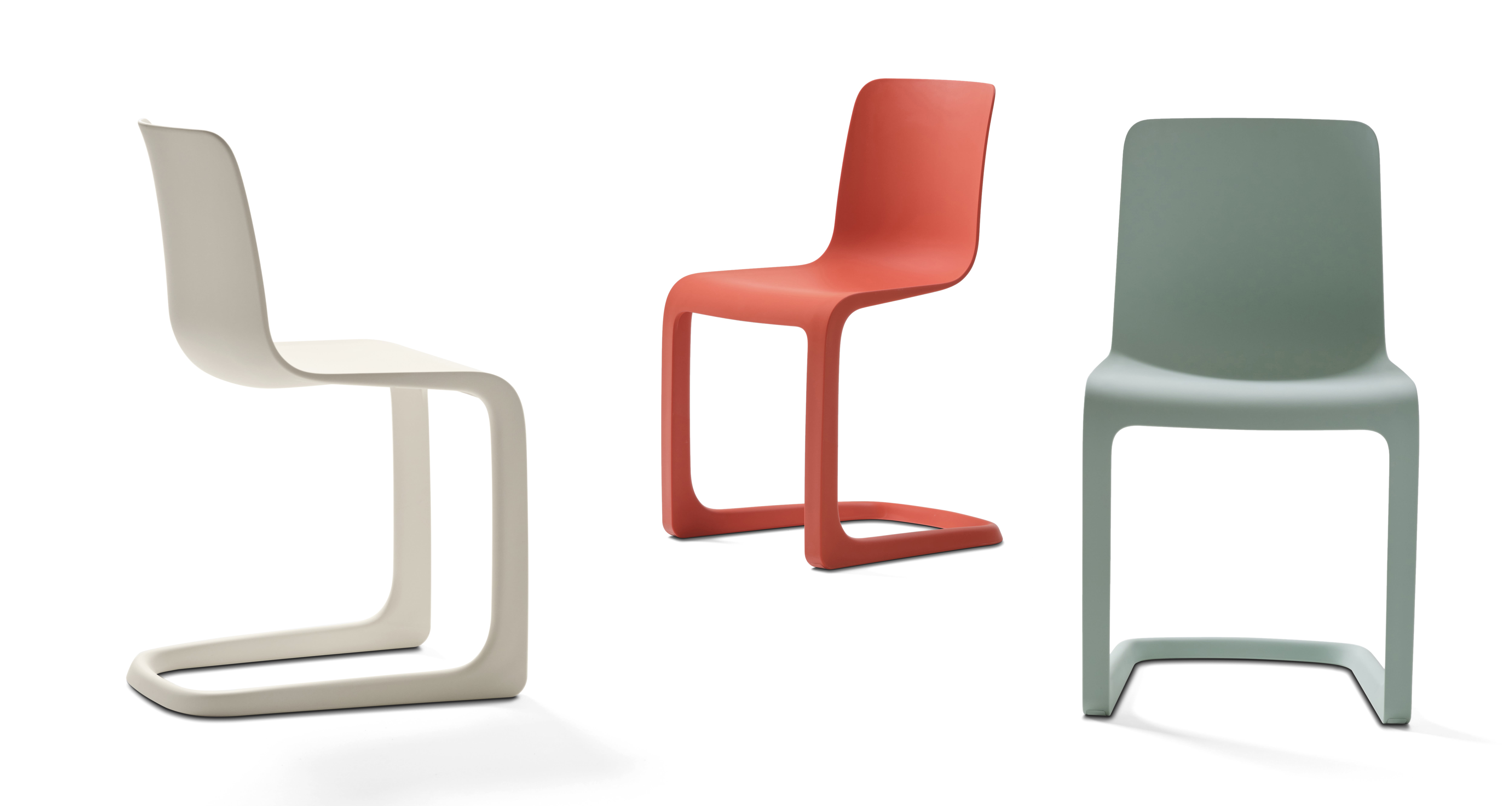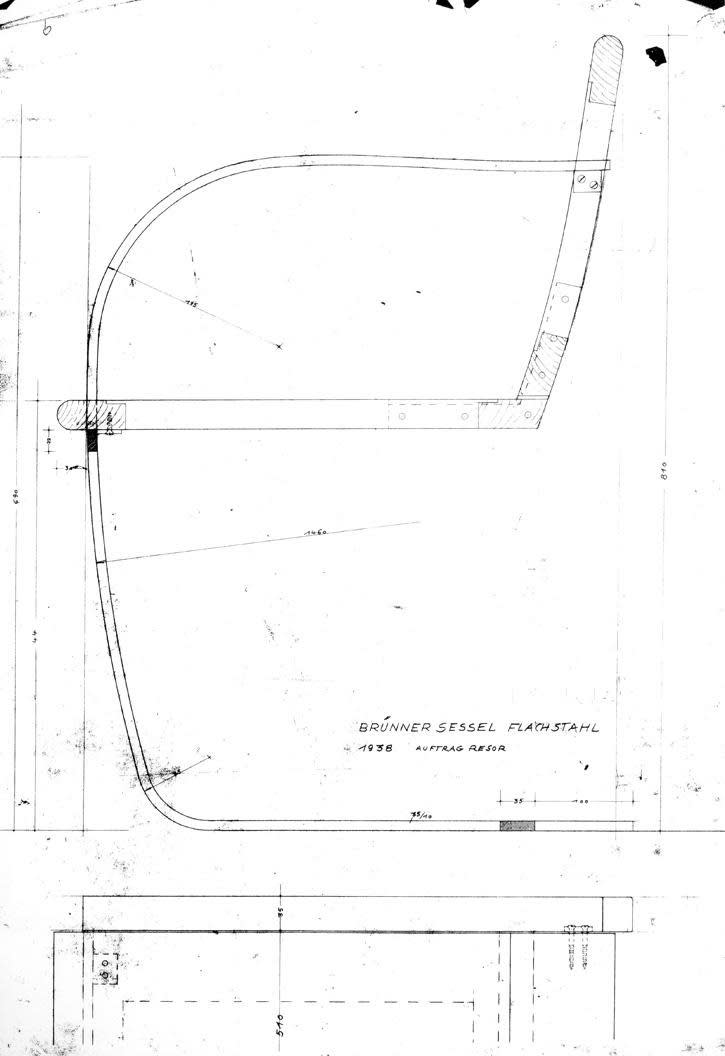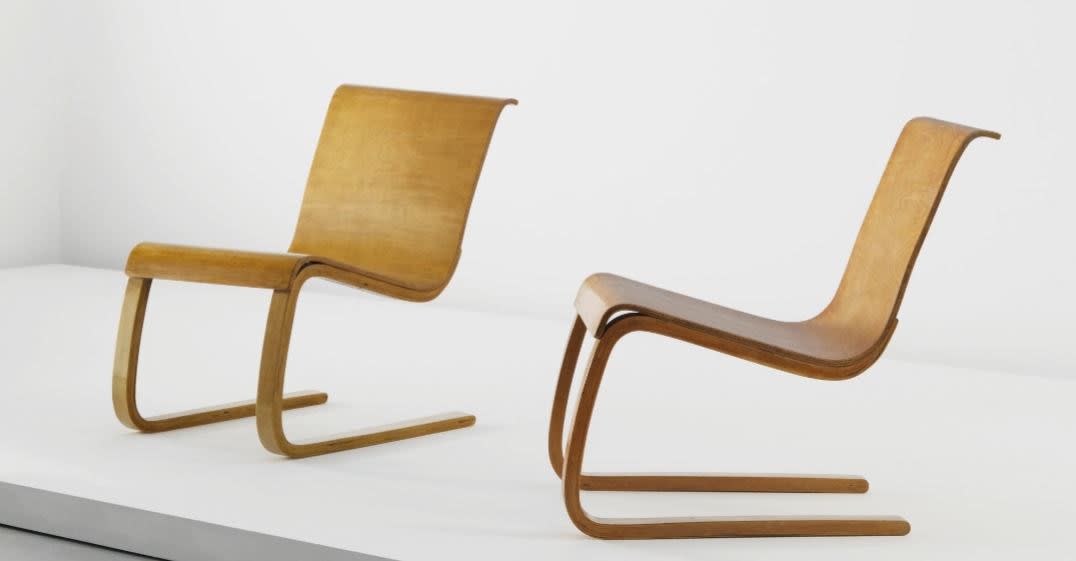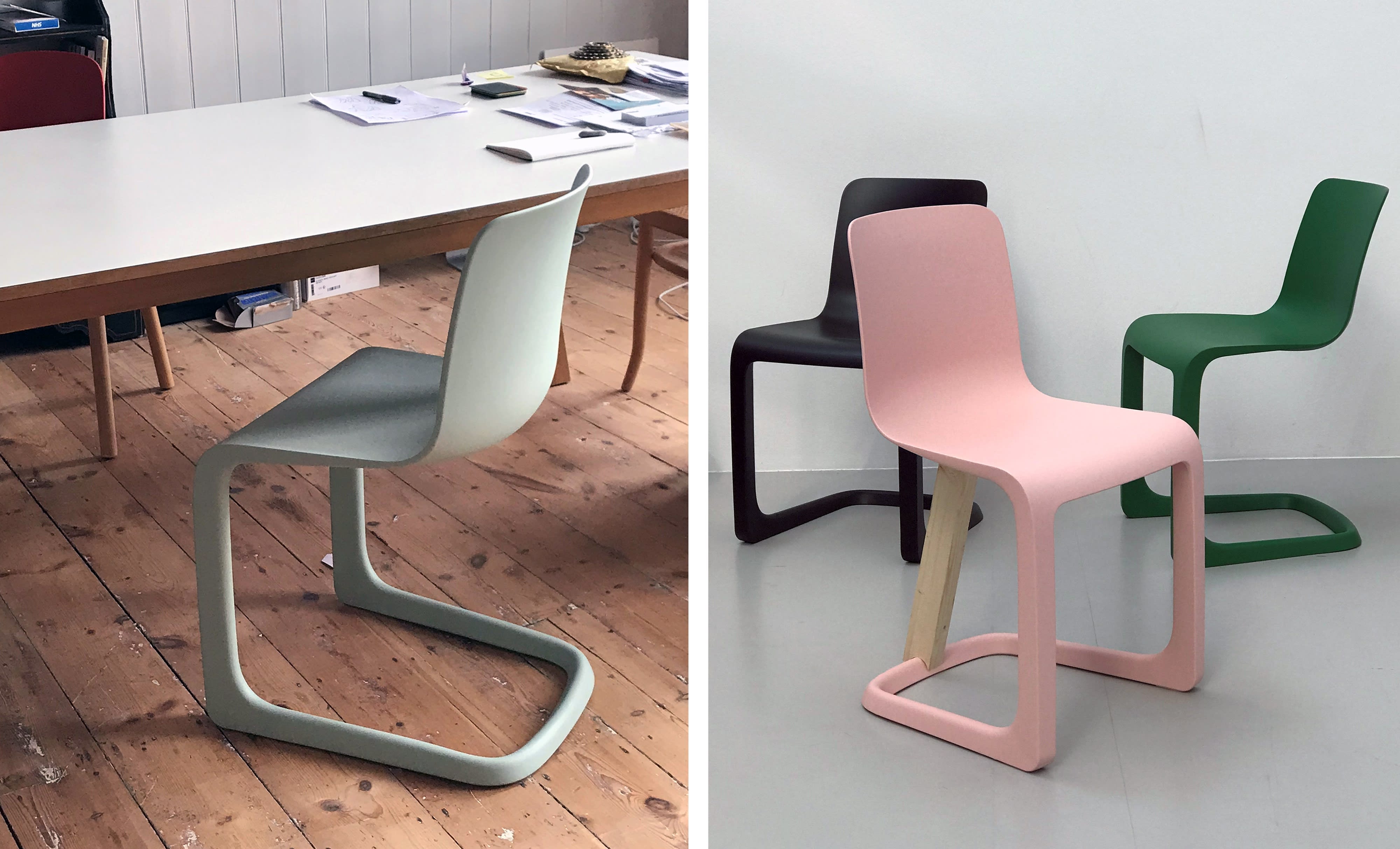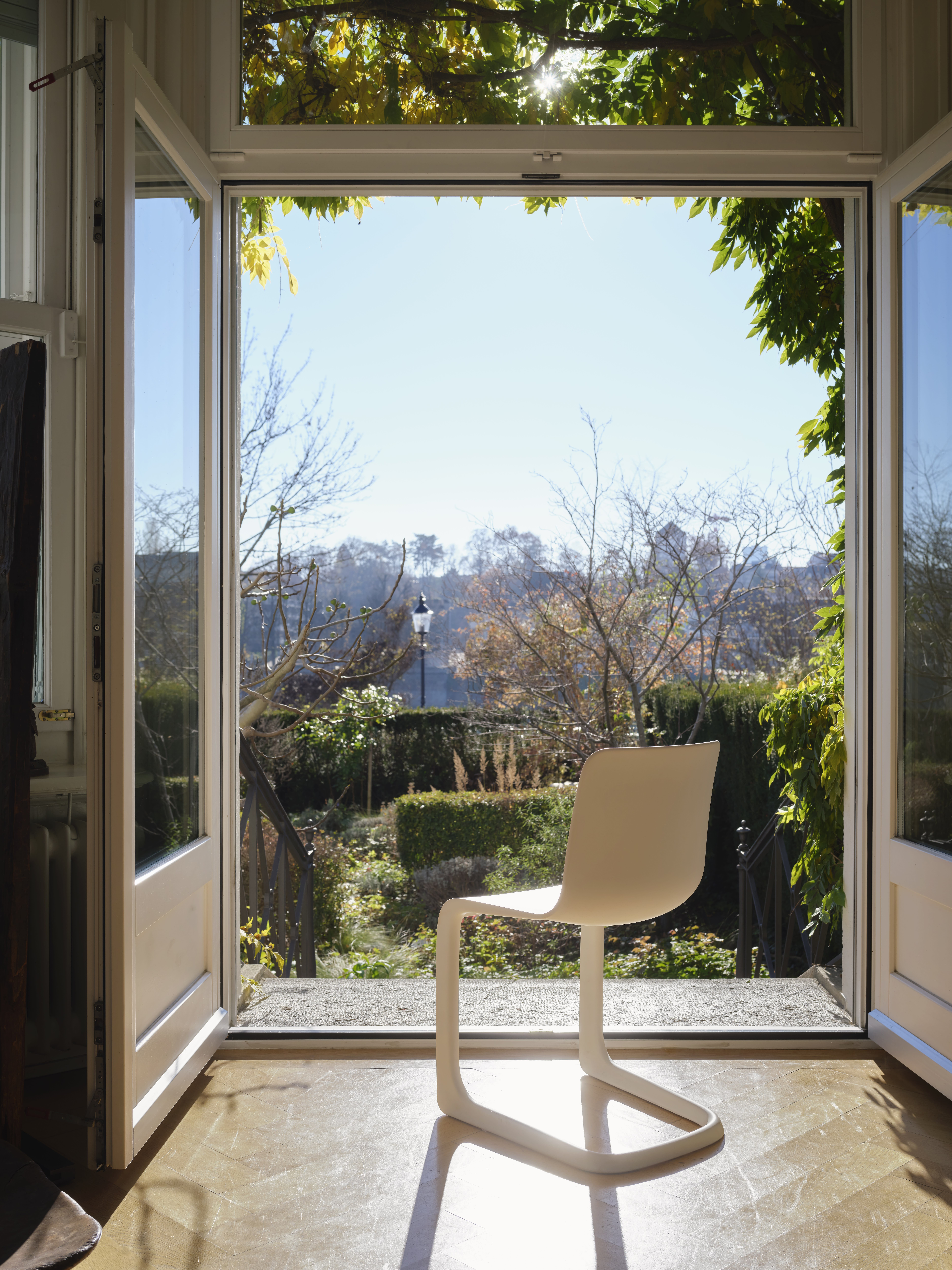-
twentytwentyone have worked with both Jasper Morrison and Vitra since their foundation 25 years ago. We are excited to provide insight into their latest project, the 'EVO-C' chair, and share an exclusive Q&A between Jasper and Max Fraser.
The EVO-C is the first successful translation of the basic principle and functional characteristics of the classic tubular-steel, cantilever chair into an uncompromising, all-plastic chair.The two-legged chair hailed as one of the greatest inventions to emerge within recent furniture design history, was introduced by Mart Stam in 1926. His experimental prototype, the first without back legs, consisted of gas pipes connected with elbow fittings. Many of the most renowned furniture designers of the twentieth century have experimented with the cantilever typograph from Breuer's tubular steel design to Panton's 'S-Chair'.
The EVO-C uses advanced gas injection moulding technology to successfully exceed the properties of tubular steel; most notably in the extra flex provided by the backrest. The load-bearing element is formed by hollow tube-like components that seamlessly flow into the surface of both seat and back. The chair offers exceptional ergonomic comfort through its generously curved surfaces, while the use of a single material establishes a gracefully cohesive appearance.
The EVO-C's uncompromisingly novel interpretation of a pioneering typology may secure its place next to the Panton Chair within the richly diverse history of chair design.
-
Q&A
Max Fraser You have worked with Vitra’s Chairman Rolf Fehlbaum and his team since 1989 and been responsible for some of the best-selling and most recognised designs in the company’s recent history. You’ve tackled a variety of furniture typologies for the brand but never a cantilevered chair – how did the EVO-C project begin?
Jasper Morrison It began with a question from one of Vitra’s product developing engineers: could we achieve a one-piece moulded cantilever chair with two front legs, in other words, could we go a step further than the Panton chair and design a two-legged version as a single plastic moulding. Rolf Fehlbaum, who as a youthful Vitra employee was instrumental in persuading his father to take up the challenge of producing the Panton Chair more than 50 years ago, was immediately behind the idea of Vitra taking the next step with newly available technologies and materials.
Panton Chair in development by Verner Panton
MF How do you start such a project - are you sketching or model making in a traditional manner, or does the material and construction process warrant computer aided design from the offset? How long was the evolution of this design and what were some of the material challenges and engineering limitations that informed the final design solution?
JM It started as a sketch after the question was asked, which shows the power of dialogue more than anything, as I would never have made the sketch without the question. That was about five years ago, since then we have made several hundred iterations of a 3D computer drawing. The changes were partly aesthetic but mostly they were down to adjusting the sections and material thicknesses to have the right combination of strength and flexibility.
© Jasper Morrison
MF EVO-C is a technically complex construction of gas injection-moulded polypropylene that provides structural strength where required; the two front legs are a hollow, skeletal structure – strong yet lightweight. Knowing that reduction and simplicity are key to your ideologies, what were the struggles to ensure you married elegance and personality with strength and the all-important ‘cantilever bounce’?
JM The main struggles were the thickness of the legs, the length of the foot (to avoid tipping) and the detailing of how and where to end the gas-moulded tubular parts. There were many more struggles on the engineering side, stress simulations which had the computers running for weeks to estimate whether the design was strong enough and if not then where it needed strengthening. Test moulds of the legs to check them in reality, with snaking lengths of tube to simulate the flow of the gas through a certain length without building an expensive larger mould. And eventually when everything seemed to be working well enough, they started cutting the mould which is a monster of moving parts and channels for the gas to get in. The achievement is 9 parts engineering to 1 part design.
© Jasper Morrison
MF Where do you envisage the chair being used?
JM I think it fits in well to a wide variety of different spaces. It’s a quiet enough shape and its modernity is balanced by a curvaceousness which can seem almost decorative in older interiors. I think it could work well around a meeting table or at home as a dining chair or on its own at a desk. I can’t think of another chair I’ve designed with such a Zelig-like ability to fit in!
MF The chair is available in three colours – poppy red, ivory and light mint. What’s involved in the decision-making on the spectrum and the quantity of colours for EVO-C? How do you design in timelessness with the changing whims of our colour preferences?
JM Vitra have a highly talented colour person and the process involves me and them choosing colours after which a line up of full-size models of the chair get painted, starting with more colours and then narrowing by committee to whatever number is deemed efficient for manufacturing. If sales are good then we may add more colours later.
MF Tell us about the name - what does EVO-C mean?
JM It stands for Evolutionary Chair, which would have been too long a name. It’s pronounced EVOK. The point of the name is to emphasize the continuation of an evolutionary path for this particular type of chair which started with Mart Stam’s original which was made from plumbing tubes and elbow joints, passed through the curved wooden versions by Alvar Aalto, to the Verner Panton model (also made by Vitra) with many other notable variations.
MF Your understanding of design history is encyclopedic, and it must be difficult to know the lineage of this typology of seating and still create an individual personality in your design. Is this a constraint or an assistance in developing the design?
JM I probably know less than most secondhand dealers. My knowledge consists mostly of accumulated visual memories of different types of chairs and my hand is guided in a subconscious way by all those examples. If I didn’t know about all of those other chairs, I doubt I’d be good at designing anything new. If I analyse EVO-C now I could say that the flatness of the front legs comes from the Aalto wooden chairs where the thin plywood seat surface sits almost flat on top of the flat bentwood legs creating the impression of a continuous surface. The loop of the legs and base relates more to the early tubular Bauhaus models, while the seat and backrest are an in some ways an update of the Panton chair, except that the blade-like effect of the backrest is new I think.
MF We’re chair-trainspotters. What are your landmark cantilever designs – top 3?
JM I would definitely like to own one or two of the low Aalto cantilevers without arms, I love the curve of the flat front leg in Mies van der Rohe’s Brno Chair, and the Panton chair itself is such a magical folding of material so that would be my number 3.
Brno Chair by Mies van der Rohe
Cantilevered low chairs by Alvar Aalto
 Classic Panton Chair by Verner Panton
Classic Panton Chair by Verner PantonMF Working in plastic has inherent responsibilities, particularly in an era when the material is in the spotlight for its use of fossil fuels and its enduring presence in the natural environment. EVO-C is made from a virgin material and engineered with durability and longevity in mind. Were there reasons why post-consumer plastic was not used?
JM Yes, for the moment the chair would not be strong enough to be made with post-consumer plastic, but no doubt the time will come when it could be. For now, it’s important to keep in mind that a well made and designed plastic chair has a useful life of 20-30 years and can be recycled after that. In terms of Cradle-to-Customer carbon footprint, it's equivalent to a ride in your car of 67km; 3 intensively farmed beefsteaks; one Christmas dinner or two-thirds of a pair of jeans.
The single use plastic a typical household consumes in a year weighs in at about 4 EVO-Cs, and most of it gets burnt to recoup energy. During the lifecycle of this chair, recycling will necessarily need to become more efficient and articles that contain virgin material will be highly valued for making other useful products. There’s no comparison between a chair with a long life and the vast majority of short-term plastic and other fossil fuel products that get wasted without a thought. I’d go further and say that making a plastic chair is one of the most appropriate uses of fossil fuel, storing it usefully for the future without wasting our resources.
MF Manufacturing EVO-C from a single material makes the chair easily recyclable should the product reach the end of its life. At that stage, who’s responsibility is it for the chair to be successfully recycled and the material circled back into the supply chain?
JM In an ideal world, the recycling system would be good enough to make better use of our valuable resources, so that instead of ending up in an incinerator being burnt to provide energy to poorly insulated homes, those raw materials could be more efficiently deployed. As the most damaging uses of fossil fuels are replaced by more efficient energy supplies, less polluting packaging, manufacturers’ exchange programs, and superior recycling programs, we will also have a much better idea of what we can and can’t afford to produce. So twenty years from now when the first EVO-Cs reach the end of their useful lives, I expect we will have ironed out most of the inefficiencies of today’s wasteful consumption.
MF In light of Covid-19 and the climate emergency how do you think you and Vitra will respond to the societal shifts in the way we live and work?
JM I just read a gloomy article in the Financial Times that suggested that, after Covid-19, we will probably go straight back to our wasteful ways as was the case after the Great Depression in the 1920’s. I’m not so sure, it’s hard to imagine businesses who have discovered they don’t need to travel so much rushing back to spending money they don’t need to. If people work at home 2 or 3 out of 5 days there’ll be less commuting. Technology will provide big improvements and efficiencies too. The home environment will be much more important than it has been. I’ve always cared more about creating good atmosphere than anything else and I’ll be happy if that’s something that’s more in demand!
Thanks to Jasper Morrison and Max Fraser.
Also to the Vitra Design Museum for the following film, highlighting the historical development of the two-legged cantilever chair from 1925 - 2021.
-
EVO-C is available to buy through twentytwentyone by following the link below.
-
EVO-C chair £285


